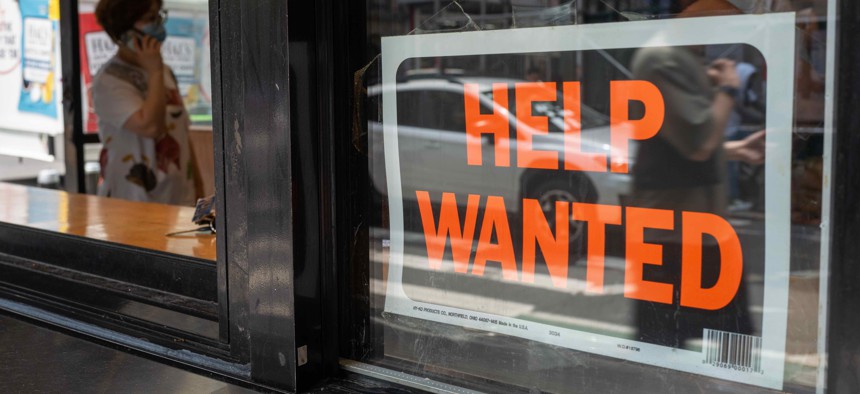The Industries Most Affected by America’s Labor Shortage

Spencer Platt/Getty Images
COMMENTARY | Lawmakers and government officials need to seek out solutions now and build their workforce development strategies around them.
Nearly three years into the pandemic, America is still experiencing a labor shortage. About 3.5 million workers are “missing” from the workforce, according to Federal Reserve Chairman Jerome Powell.
That is how much bigger the labor force would be if the number of people working or looking for work returned to pre-pandemic levels. But as it is, there are more openings than job seekers.
Retirements are largely to blame for this gap.The Federal Reserve found that retirements in the last two years account for “nearly all of the shortfall” in the labor force. Other factors include child care and automation.
Workforce development has become a key priority for state and local governments amid the shortage of workers. Policymakers in several states have turned to new workforce-oriented initiatives, from tuition incentives and paid apprenticeships to boot camps to solve the missing worker problem. Indeed, lawmakers and government officials need to seek out solutions now and build their workforce development strategies around them.
The reduction in the labor force has affected some industries more than others. These, the U.S. Chamber of Commerce recently reported, are the key sectors to watch:
Transportation
Labor shortages are plaguing the transportation industry nationwide, disrupting one of the economy’s most critical support systems.
The sector is struggling to hire truck drivers, warehouse personnel, couriers, skilled technicians and public transit workers.
The most recent report from the Bureau of Labor Statistics (BLS), for example, details the downward trend in warehousing and storage personnel and in couriers and messengers. These logistics positions are down between 3,000 and 4,000 jobs this time last year.
Public transit is facing similar shortages. The American Public Transportation Association released a report indicating that 96% of the agencies surveyed reported a workforce shortage, and 84% of those said it was affecting their ability to provide service.
The public transportation shortage negatively impacts the entire economy as residents who use public transit for work have found it to become increasingly unreliable despite ongoing efforts, and private transport is too cost prohibitive. A 2018 Politico report demonstrated an individual’s reliance on public transportation to get to work: “87% of public transportation trips directly benefit the economy by getting people to work and connecting them to local businesses.”
Accommodation and Food
While the leisure and hospitality sector added an average of 82,000 jobs monthly in 2022, according to BLS, industry employment is still below pre-pandemic levels by 5.8%.
The American Hotel & Lodging Association’s most recent survey of hotels across America found that 87% of respondents were experiencing a labor shortage, with 36% reporting the need as severe. The biggest challenge they noted was finding housekeeping staff, which directly led to a reduction in rooms available to rent. Other parts of the hotel were also affected, with some hotels closing their restaurants and limiting other services previously provided. Some hotels have even replaced front desk clerks with self-service kiosks.
The stats in the restaurant industry are equally alarming. According to the National Restaurant Association’s 2022 State of the Restaurant Industry Report, 96% of their restaurant operators reported supply chain delays or shortages. Finding the staff to prepare and serve the food has also been challenging, even with employers increasing the minimum wage to entice applicants.
Health Care
Unsurprisingly, the pandemic has been a considerable factor in worker shortages in health care.
AMN Healthcare, which provides staff to hospitals and other health-care facilities, recently found that 85% of the facilities they surveyed are still experiencing a shortage of allied health-care professionals. This group, which includes radiology technicians, sonographers, dental hygienists and physical therapists, are critical to the continued function of the health-care system.
Roughly 46% of the surveyed facilities reported that burnout was a massive factor in staffing losses. This has led to an increase in temporary workers and a huge demand for newly graduated health-care professionals. Many worry that these challenges have decreased the quality of health care that patients receive due to the lack of experience.
Retail Trade
Retail employment has fallen by 62,000 employees since August, according to the BLS. Although 4% retail exits were due to resignations last year, the vast majority are because of layoffs. And, perhaps unsurprisingly, brick and mortar is disproportionately affected by forced layoffs compared to their online cousins.
“Retailers are already running fairly lean,” a Deloitte consultant charged with examining the retail sector noted. “How can retailers deliver the customer service promised and do it in a cost-effective manner with even fewer people? When customers are unhappy in the store, they go home and order it online.”
This can have economic development repercussions for cities that are already dealing with empty storefronts.
Fabian Sandoval is an HR analyst for small and medium businesses. He recently launched his writing career sharing his insights on employee productivity and streamlining company-wide projects. He specializes in simplifying mundane HR tasks and providing solutions to problems that often pop up in a remote work environment.
NEXT STORY: State & Local Roundup: Wealth Tax Proposals on the Rise





